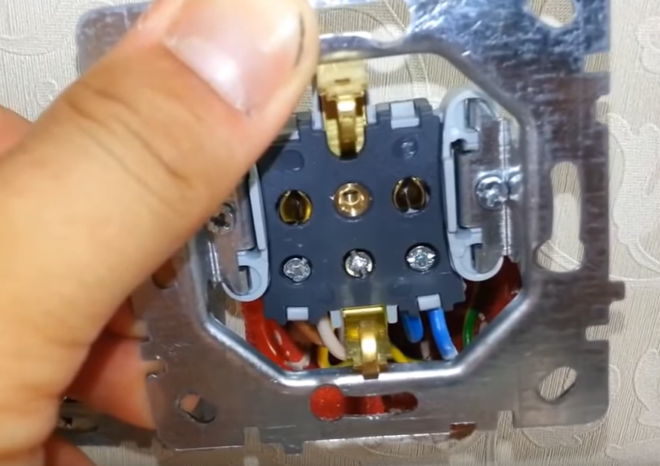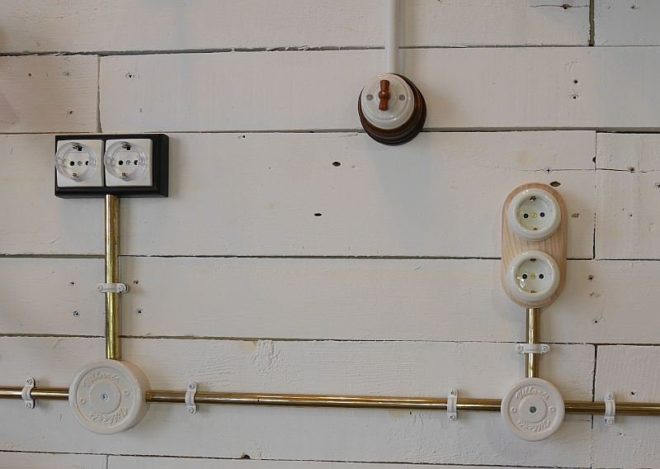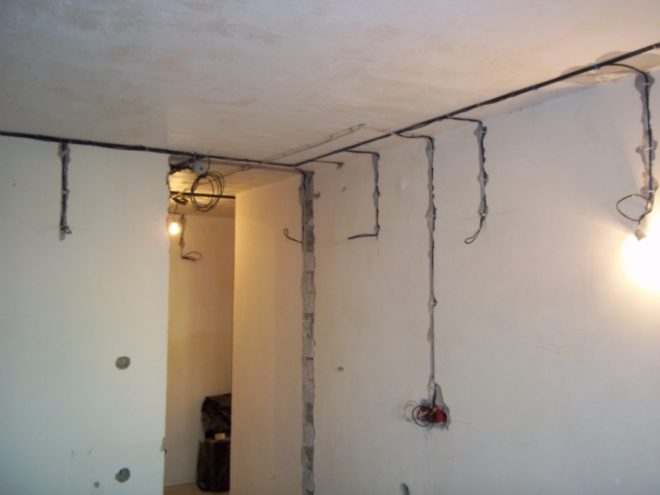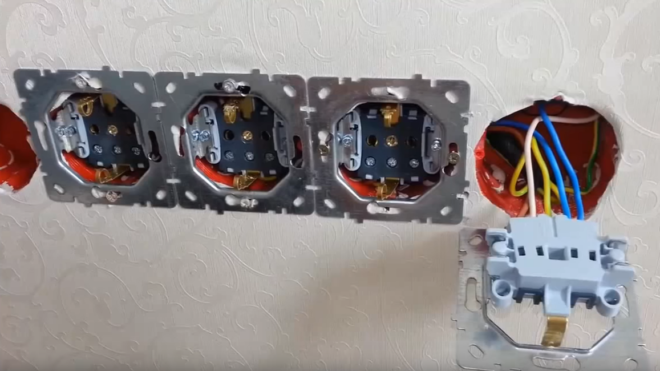How to connect the outlet correctly - detailed instructions

Before connecting the outlet, you need to decide how exactly to connect it to the existing network. To do this, you need to imagine exactly how it will be used in the future: for one electrical appliance of low power or for several devices.
Content
Open and closed wiring
The difference between the methods and visible to the naked eye. The closed wiring is located inside the wall, for which grooves (grooves) are punched or cut in it, in which the connecting wire is hidden under a layer of putty. Open wiring is laid along the surface of the wall, on which it is held in special fasteners or laid in plastic guides - cable channels.
Accordingly, if you can see the wires that fit the outlet, then the wiring is open. Otherwise, closed wiring is used, for the laying of which the walls were cut.
These two ways in which the outlet is connected can be combined with each other - if the old points are connected in a closed way, then nothing prevents you from connecting a new one open. There is no choice in only one case - in wooden houses, the socket can be connected exclusively in an open way, as well as all other electrical wiring.
Open wiring - advantages and disadvantages

An analogy with the most common extension cord (surge protector), which is essentially an additional branch of the electrical network, but is connected not to a junction box, but to an outlet, will help to understand what is good about open wiring.
Benefits:
- You don't have to cut the wall to install a new outlet. This is especially true for those premises that have already been renovated.
- For installation, you do not need tools such as a wall chaser or a hammer drill.
- In the event of a breakdown, you do not have to open the wall - all the wiring is in front of your eyes.
- Installation speed. Even after all the work has been completed, adding one more point to the existing layout is a matter of a few minutes.
- If desired, you can completely change the wiring quickly enough - ideal for temporary connection schemes.
Disadvantages:
- There is a high probability of external influence on the wiring - children, pets, you can simply accidentally hook them. This disadvantage is leveled by laying wires in cable channels.
- Open wires spoil the entire interior of the room. True, it all depends on the design skills of the owner of the room - cable channels will perfectly fit into modern design solutions, and if the room is made in a retro style, then special wires and other accessories are produced for this.
- The need to purchase special fasteners, even if cable channels are not used - in wooden houses, open wiring should be laid at a distance of 0.5-1 cm from the wall surface. Often, wires are laid inside iron pipes - all these requirements are aimed at increasing the safety of using open electrical wiring.
As a result, this method of connection justifies itself if, for some reason, there is no point in laying wires to the outlet inside the wall. Besides the fact that the wiring will be visible, there will be no differences in the operation of the outlet.
Hidden wiring - pros and cons

Despite some significant drawbacks, it is used almost everywhere - the advantages of its use still outweigh.
Benefits:
- The wires to the outlet fit in the wall, so wallpaper is freely glued outside or other finishing is done.
- Meets all fire safety requirements (in concrete buildings) - even if a short circuit occurs, there is no need to be afraid of a fire from the wires in the wall.
- Very low probability of damage to the wiring - it can only be damaged while drilling the walls.
Disadvantages:
- For installation, you need to cut the walls.
- Repair work is difficult.
- If the walls are finished, then after laying an additional outlet, you will have to redo it.
Disadvantages are leveled by preliminary calculations - if you plan in advance where and which block of outlets you need to install, then problems in the future usually do not arise.
Existing connection methods
Two or more sockets can be connected relative to each other and other circuit elements in only three ways: in series, parallel or mixed connection. In other words, the first two methods are called daisy chain and star connection.
Each of them has its own advantages and disadvantages, which must be taken into account before deciding which circuit for connecting the sockets will be used in each specific case - it mainly depends on which cable is needed and its number.
No less attention should be paid to what wiring is already installed in the apartment - if the connected device is high power, then it is likely that to connect the outlet you will have to pull a new wire from the switchboard near the meter.
The most important rule that in all cases must be taken into account when connecting outlets into circuits is that each twisting of wires together is a weak link in the electrical circuit - the more there are, the higher the likelihood that the wiring will fail over time.
Parallel connection - star connection
 The essence of the method is that the connection of several points occurs in one place on which the entire load falls while simultaneously turning on electrical appliances. In practice, parallel connection of sockets means that one main cable comes into the junction box of the room, from which the remaining sockets are powered. An important point is that with this method, a separate wire goes to each point from the junction box.
The essence of the method is that the connection of several points occurs in one place on which the entire load falls while simultaneously turning on electrical appliances. In practice, parallel connection of sockets means that one main cable comes into the junction box of the room, from which the remaining sockets are powered. An important point is that with this method, a separate wire goes to each point from the junction box.
The advantages of the method are obvious - each outlet works autonomously and if one of them fails, the rest will continue to work. The disadvantage is that if the central contact, from which all points are powered, burns out, then there will be no voltage in any of them, but this is also an advantage, since it will be known with a high degree of certainty where to look for a break.
The next drawback, which stands out for the parallel connection of the sockets, is the high consumption of the wire, because a separate conductor must be laid from the central contacts to each point. The problem is partly solved by the fact that a wire of a larger cross-section can be laid to the central contacts, and a thinner wire can be run from it to the sockets, but in this case, an already mixed connection is used.
Serial connection - daisy chain connection
 Connecting the sockets with a loop means connecting them one after the other, and instead of twisting wires, the contacts of the sockets themselves are used. Those. phase and zero come to the first outlet, and from it the wires are thrown to the second, third, and so on - to the last point.
Connecting the sockets with a loop means connecting them one after the other, and instead of twisting wires, the contacts of the sockets themselves are used. Those. phase and zero come to the first outlet, and from it the wires are thrown to the second, third, and so on - to the last point.
In its pure form, the connection of sockets with a loop is used only if it is necessary to connect a block of outlets or move the point a certain distance. In the latter case, the old socket is not always removed - it is often left, because if there is a rearrangement, then it is inappropriate to pick the wall again.
The next feature that stands out is the connection of sockets with a loop - you cannot connect powerful devices such as air conditioners, washing machines, microwave and conventional electric ovens to them. This prohibition is dictated by the large number of connections that distinguish the daisy chain connection, and each of them is a weak link in the electrical circuit.
Connecting a block of outlets with a loop is described in detail in this video:
Mixed connection and ground in daisy chain
 To increase the reliability of the wiring when using a daisy-chain connection of outlets, you can use a mixed connection. Its essence is that the main cable comes into the junction box of the room, and then the farthest outlet is connected from it. Further from this wire, branches are made to the rest of the outlets, which are located between the far point and the junction box.
To increase the reliability of the wiring when using a daisy-chain connection of outlets, you can use a mixed connection. Its essence is that the main cable comes into the junction box of the room, and then the farthest outlet is connected from it. Further from this wire, branches are made to the rest of the outlets, which are located between the far point and the junction box.
With this connection, the cable for wiring is saved, and the reliability of the network increases, since if one of the sockets fails, the rest will work (unless the twist near the main cable burns out).

When a serial connection of sockets is used, therefore, grounding is mandatory - if you simply draw a ground wire from terminal to terminal, then if it burns out on one of them, the remaining sockets remain unprotected. If you run one cable through all the sockets, but make a branch near each of them, then the reliability increases.
The most correct way to correctly connect the outlet with a mixed connection, which is used in most cases, is to run the main wire under the ceiling and branch down from it to the outlet boxes. If the cross-section of the wiring allows, then there you can already connect several points with a loop to one descending wire.
The disadvantage of such a connection is the same as that of a serial connection - a large number of twists (plus, on each branch, you need to make a small junction box). In order not to think once again whether it is possible to plug powerful electrical appliances into such sockets, it is necessary to carefully calculate the wiring, and it is better to use a parallel connection.
In this video, you can see how a mixed connection is made: the ground is connected through a branch, and the phase and zero are connected with a loop.
Ring connection
 A somewhat exotic connection scheme for post-Soviet countries, but, undoubtedly, has its own advantages. Its meaning is to lay a full circle of the main cable from the main electrical panel throughout the apartment, which will return to its beginning. In each room, cuts are made into it, which will be the junction boxes, from which its ring is laid around the room, and from it the branches already go to individual sockets or their loop groups.
A somewhat exotic connection scheme for post-Soviet countries, but, undoubtedly, has its own advantages. Its meaning is to lay a full circle of the main cable from the main electrical panel throughout the apartment, which will return to its beginning. In each room, cuts are made into it, which will be the junction boxes, from which its ring is laid around the room, and from it the branches already go to individual sockets or their loop groups.
In this case, if the wire burns out anywhere, then the subsequent part of the wiring remains working, since the current will come to it from the other side of the ring. Thus, in terms of reliability, this method is practically no worse than a parallel connection. On the other hand, if the wiring burns out, then in any case it must be repaired, and the wire consumption is still higher than that of a standard connection.
How to choose the right way
Everything depends on the amount that you can afford to spend, the power of the device that will be connected to this outlet, as well as the presence or absence of decoration on the walls (the desire and ability to spoil it).
In any case, the most reliable way to connect any outlet is a separate (parallel) connection directly to the main panel or junction box in the room (if the cable size allows).If the outlet is planned only for connecting a TV or similar not very powerful devices, then a daisy chain connection is quite suitable.
If wiring is planned in a new house or modernization (replacement) of an old one in an apartment, then first of all it is necessary, without undue modesty, to imagine what electrical appliances one would like to have - what can be connected to the network in principle. Based on this, it is already possible to calculate the required cross-section of wires and the method of connecting them.




